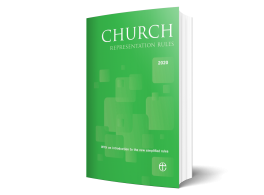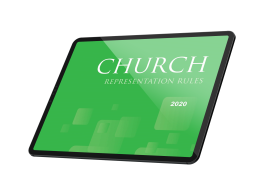Introduction to the 2022 Edition
New Church Representation Rules came into operation in 2020. Although they entirely replaced the previous Rules, many of the concepts remain familiar. The Rules continue to provide for church electoral rolls, annual meetings, parochial church councils, deanery synods and diocesan synods, and the House of Laity of the General Synod. But there are significant changes to the way in which the Rules are presented and to their substance.
The new Rules were completely redrafted so that they were easier to understand. They are no longer characterised by over-long sentences; provisions were broken down into more easily digestible parts. The provisions relating to parish governance are set out in a self-contained Part of the Rules (Part 9). This has made navigation around the rules easier.
One of the most significant reforms was provided for in Part 2 of the new Rules. The default position is now that the model rules for parish governance set out in Part 9 apply to each parish. But the annual meeting of any parish can make a scheme to amend, supplement or replace the model rules. This makes it possible for a parish to make governance arrangements that are best suited to the mission and life of the church in that parish. A small number of essential provisions are mandatory; and a scheme making rules for a parish has to be approved by the bishop’s council who must be satisfied, among other things, that the scheme makes due provision for the representation of the laity, and that it ensures the effective governance of the parish.
Another major reform was the provision for joint councils in section C of Part 9. Under the new Rules, joint councils can now replace the individual PCCs. Where that happens the number of local bodies – and the number of meetings – is reduced and should result in a significant reduction in the administrative burdens imposed on clergy and laity.
The new Rules were designed to be compliant with recent data protection legislation; they now provide for electronic communication, for better representation of mission initiatives in the Church’s structures; they enable parochial church councils to do business by correspondence; and they provide that lay people must form a majority of a parochial church council.
Since the new Rules came into operation in 2020, some amendments have been made by the General Synod. These include:
• A revised system for appeals in relation to elections held under the Rules (for example, elections to a deanery or diocesan synod). See rules 57A to 61I.
• Clarification of the term of office for co-opted members of parochial church councils. See rule M17(4).
• Removal of the automatic limit on the number of terms that a parochial representative of the laity may serve on a deanery synod, there being a limit only if the annual parochial meeting imposes one for the parish. See rule M8(5) to (7).
Basic outline of the new Rules
• Part 1 (church electoral roll) makes provision for the compilation and revision of church electoral rolls.
• Part 2 (parish governance) provides for the model rules in part 9 to apply to each parish. But that is subject to the other provisions of Part 2 which enable a parish to make a scheme to amend or supplement, or to replace the model rules under the procedure set out in that Part.
• Part 3 (deanery synods) makes provision for the composition of, and elections to, deanery synods.
• Part 4 (diocesan synods) makes provision for the composition of, and elections to, diocesan synods.
• Part 5 (House of Laity of the General Synod) makes provision for the membership of, and elections to, the House of Laity.
• Part 6 (appeals) makes provision for appeals against decisions relating to enrolment on a church electoral roll and elections.
• Part 7 (disqualification etc.) makes provision for persons to be disqualified from serving as a member of synodical bodies and for the vacation of a member’s seat on such a body in specified circumstances.
• Part 8 (miscellaneous) makes miscellaneous provisions for the purposes of the Rules, including provisions relating to the handling of personal data, casual vacancies, communication by email or post and interpretation.
• Part 9 (parish governance: model rules) contains the model rules for parish governance. These provide for matters such as annual and other parochial church meetings, elections of members of parochial church councils (PCCs) and deanery synods, the composition and business of PCCs, and the making of schemes for joint councils for “connected parishes”. The model rules will apply automatically unless a parish makes a scheme under rule 12 to amend or supplement, or to replace, the model rules.
• Part 10 (forms) contains the forms which are required to be used for the purposes of the Rules.
• Part 11 (index) contains an index of defined terms for the purposes of the Rules.
Summary of main features of the new Rules in operation since 2020
The new Church Representation Rules implemented a range of reforms. These included the elimination of various procedural requirements relating to parish governance, the separation into a separate part of the Rules of model rules relating to parish governance, provision enabling parishes to make their own rules (with the agreement of the bishop’s council), provision enabling connected parishes to establish joint councils in place of their separate PCCs, and updating the forms. The principal reforms that came into operation in 2020 are outlined in the following paragraphs.
Revision of church electoral roll and preparation of new roll
The provisions relating to the revision of church electoral rolls and the preparation of new rolls in Part 1 are simplified. Names no longer need to be removed from the roll during the course of the year; they only need to be added: see rule 2. Names are still removed, as appropriate, at the annual revision: see rule 4. Provision has been made to avoid a person’s name incorrectly being removed from a roll: see rule 4(8).
Rolls may be published electronically instead of in paper form. The roll as published must include every name entered on the roll but not other personal data (e.g. addresses). See rule 5.
Annual meeting
The annual parochial church meeting may now be held between 1 January and 31 May (rather than 30 April): see rule M1.
The annual meeting no longer appoints sidesmen; they are now appointed by the PCC: see rule M6(6).
Parochial church councils – ensuring lay majority
Lay members of a PCC cannot be outnumbered by clerical members: see rule M15(2). A meeting of the PCC is quorate only if the majority of members present are lay: see rule M27(2).
Parochial church councils – meetings
The Rules no longer specify a minimum number of PCC meetings which must be held each year. Instead, the PCC is required to hold a sufficient number of meetings to enable the efficient transaction of its business: see rule 23(1).
The Rules now expressly state who is entitled to attend a PCC meeting. A PCC may invite other persons to attend its meetings as it wishes. See rule M24.
Parochial church councils – conduct of business by correspondence
Provision is now made in the Rules to enable PCCs to conduct business by correspondence (whether on paper or by email) where the chair of the PCC decides that particular business can properly be conducted in that way: see rule M29.
Joint councils
The Rules enable the annual meetings of ‘connected parishes’ to make schemes establishing a joint council: see section C of Part 9. Parishes are ‘connected’ if they belong to the same benefice, if they belong to benefices held in plurality or if they are in the area of the same group ministry. A scheme establishing a joint council can transfer all the property, rights, liabilities and functions of the individual PCCs to the joint council. If a scheme does that, the individual PCCs go into abeyance and no separate PCC meetings are held: the joint council does everything. Alternatively, a scheme establishing a joint council may transfer only certain property, rights, liabilities and functions – as specified in the scheme – of the individual PCCs to the joint council. If a scheme does that, the individual PCCs continue to function alongside the joint council, with the joint council exercising only the functions that are transferred to it and the other functions remaining with the individual PCCs.
Mission initiatives
The Rules make mandatory provision for the representation of mission initiatives (i.e. initiatives that are established by bishops’ mission orders) on deanery synods where the bishop so directs: see rule 24. They also provide for persons who worship in mission initiatives to be eligible for election to diocesan synods and the General Synod: see rule 36 and rule 50.
The Rules provide for the number of habitual worshippers in mission initiatives to be taken into account – together with the numbers of parish electoral rolls – when apportioning the seats in the General Synod’s House of Laity between the dioceses: see rule 49.
House of Laity of the General Synod
The apportionment of the number of members of the House of Laity between the provinces of Canterbury and York is no longer required to be 70:30 if the General Synod passes a resolution specifying some other proportion.
Electronic communication
The Rules make comprehensive provision for the use of communication by email: see rule 76. Providing an email address is optional; but if one is provided, any communication under the Rules may be sent to that email address. An email will satisfy any requirements in the Rules for a communication to be in writing. Where in the past there was an obligation to pass on addresses (e.g. by the PCC secretary to the secretary of the deanery synod), any email address given by a person must also be passed on.
Electronic voting in elections
The Rules facilitate the use of electronic voting methods in elections to diocesan synods and to the General Synod: see rule 42(5) and rule 56.
Data protection
The Rules take account of the UK General Data Protection Regulation and the Data Protection Act 2018. The Rules have been designed to avoid any need to obtain consent from individuals for processing their personal data for the purposes of the Rules. Instead, personal data can be processed in the ways required by the Rules on the basis (i) that doing so ‘is necessary for compliance with a legal obligation’ (as the Rules have the force of law); and (ii) so far as data includes ‘special category personal data’ because it reveals a person’s religious beliefs, that the processing is carried out internally in the course of the Church of England’s legitimate activities. Personal data contained in the published version of the electoral roll is data which ‘is manifestly made public by the data subject’ when he or she applies to have his or her name included on the roll and is covered on that basis.
A person who holds personal data for the purposes of the Rules must ensure that the data is held securely: see rule 72.
Further information and guidance about data protection for parishes is available on the Parish Resources website.
Notes to accompany the new Rules
Some editorial footnotes have been included in this edition of the Rules. These do not form part of the legal text of the Rules but are there to assist the reader in navigating and using the Rules.

